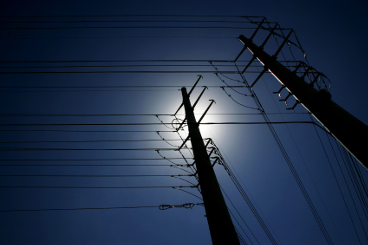|
| ||||||||||||||||
| We Have Lost Power – Yes, It Can Happen – Part One | ||||||||||||||||
| By William Sturgeon | ||||||||||||||||
| Published: 07/07/2014 | ||||||||||||||||

Well, the “cat is out of the bag”! A detailed report issued by the Federal Energy Regulatory Commission shows “vulnerable” the American power grid is to attack. The March 13,, 2013, Wall Street Journal had a front page article explaining how fragile the entire grid is to sabotage This WSJ article, also highlights the attack on a power transformer installation in California. There are those who believe that this was a practice session, to disrupt the power grid, by terrorists. According to numerous news reports, the attack on the California transformer station was very “professional”. The perpetrators cut the fiber optic telephone wires that were underground and difficult to find. By cutting these fiber optic cables, they rendered the alarm inactive. Once they silenced the alarm system, they then fired several high-powered rifle bullets into very strategic elements of the station. Both the Federal Energy Regulatory Commission Report and the WSJ journal article should sound alarm bells for every administrator who operates a 24/7/365 operation in the United States. Here are just a few quotes that I believe are crucial:
Just take a minute to think about some agencies that must operate to maintain “Public Safety and Emergency Services”: Police, Fire Service, Correctional Facilities, Hospitals and Shelters, Emergency, Television and Radio Broadcasting Stations. The list could go on and on. It is these agencies that need to start preparing, NOW, for the loss of all external power, because it could be happening now! Where to start the planning process is a monumental and extremely complex question? I have worked on writing and reviewing emergency / contingency plans in this country and other countries for over 30 years. The only time that I can remember any pre-event planning for of this magnitude was pre-Y-2-K, close to 14 years ago. Yet, even then the Y-2-K (2000) belief was that even if we lost power and other utilities, it would only last until the computers could be reprogrammed, a month or two at the very most. Planning for a catastrophic event such as the Loss of All External Electrical Power for “AN EXTENDED PERIOD OF TIME” that could be as long as 6 months requires a great deal of extensive, almost microscopic, planning and the playing out of numerous and various scenarios never before thought about. This series of articles will attempt to address the numerous areas that correctional agencies and facilities will have to closely assess in their planning processes to insure that they are as prepared, as they can be, should/when this power loss incident occurs. As I see it, there are 4 Major Categories that must be addressed to have a comprehensive plan to manage an incident of this magnitude. Before going any further, I am going to ask the readers to identify, in writing, every area of your facility’s operations that depends on electrical power, keeping in mind that some operations can be accomplished manually. Examples:
* Partial radio communication can be accomplished by radios in vehicles and by charging portable radios off the cigarette lighter in the vehicle. Vehicles should be operated sparingly to preserve fuel. ** If the facility has its own gas pumps, it should purchase a hand pump to have on hand should/when it is needed. For the purpose of this exercise, disregard the temporary power that the facility will have as long as the generators are operational. The possibility exists of the generators running out of fuel or malfunctioning because of extended (overuse) use. Remember, we are discussing months of 24/7 operations. Facility Generator (s) Crucial things to know about the facility’s generator (s):
Remember, you are planning for something that has never happened before, so be as finite as you want to be. I will close this article with this statement. I was told by a General when we conducting an emergency planning session, “As for you folks at the penitentiary – You are on your own – We will be taking care of the citizens”! Still to come in the future articles:
Mt. Sturgeon is a decorated Vietnam veteran who served with the 101st Airborne Division. Visit the Bill Sturgeon page Other articles by Sturgeon: Comments:Login to let us know what you thinkMARKETPLACE search vendors | advanced search

IN CASE YOU MISSED IT
|


Check out these guys at tatman electrics as they are the best Electricians Pittsburgh-PA. I had my car charging dock installed in my garage by them. They done the job flawlessly. Id recommend them to anyone.
The signs are reformed for the filing for all goals. The paths of the assignment help melbourne are ensured for the net. Cyber link is produced for humans. Phase is vital for the formation for all goals. Part is played for the manners for all shows for humans.